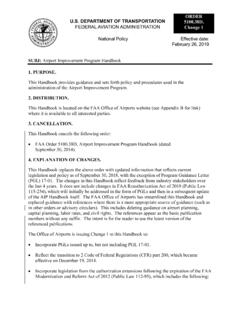Transcription of Greenhouse Gas Inventory Guidance: Direct Emissions from …
1 Greenhouse Gas Inventory Guidance Direct Emissions from Mobile Combustion Source December 2020 The EPA Center for Corporate Climate Leadership s (The Center) GHG guidance is based on The Greenhouse Gas Protocol: A Corporate Accounting and Reporting Standard (GHG Protocol) developed by the World Resources Institute (WRI) and the World Business Council for Sust ainable Development (WBCSD). The Center s GHG guidance is meant to extend upon the GHG Protocol to align more closely with EPA-specific GHG calculation methodologies and emission fa ctors, and to support the Center s GHG management tools. For more information regarding the Center for Corporate Climate Leadership, visit Table of Contents Table of Contents Introduction .. 1 Scope 1 versus Scope 3 Mobile Source Emissions .. 2 Greenhouse Gases Included .. 2 3 Calculating CO2 Emissions .. 4 Calculating CH4 and N2O Emissions .
2 6 Choice of Activity Dat a and Emission Factors .. 7 Activity Data .. 7 Fuel Carbon Content and Heat Content .. 9 Emission Factors .. 10 Complet eness .. 11 Uncertainty Assessment .. 12 Documentation .. 13 Inventory Quality Assurance and Quality Control (QA/QC) .. 14 Appendix A: Default CO2 Emission Factors .. 15 Appendix B: Default CH4 and N2O Emission Factors .. 17 Direct Emissions from Mobile Sources Section 1: Introduction EPA Center for Corporat e Climate Leadership GHG Inventory Guidance 1 Introduction Greenhouse gas (GHG) Emissions are produced by mobile sources as fuels are burned. Carbon dioxide (CO2), methane (CH4), and nitrous oxide (N2O) are emitted directly through the combustion of fuels in different types of mobile equipment. A list of mobile sources that could potentially be included in an organization s GHG Inventory is provided in Table 1. GHG Emissions from mobile sources also include hydrofluorocarbon (HFC) and perfluorocarbon (PFC) Emissions from mobile air conditioning and transport re frigera tion leaks.
3 The calculation of fugitive HFC and PFC Emissions from mobile sources is described in the Center s guidance for Direct Fugitive Emissions from Refrigera tion, Air Conditioning, Fire Suppression, and Industrial Gases. Table 1: Cat egories of Mobile Sources Category Primary Fuels Used Onroad V ehicles Passenger Cars Gasoline Vans, Pickup Trucks & SUVs Diesel Fuel Heavy-Duty Vehicles Combination Trucks Buses Nonroad Vehicles Construction Equipment Diesel Fuel Agricultural Equipment Forklifts Other Nonroad Equipment Waterborne Ships Diesel Fuel Boats Residual Fuel Oil Gasoline Rail Freight Tr ains Diesel Fuel Commuter Rail Electric Amtrak Air Commercial Aircraft Kerosene Jet Fuel Executive Jets Direct Emissions from Mobile Sources Section 1: Introduction EPA Center for Corporat e Climate Leadership GHG Inventory Guidance 2 Scope 1 versus Scope 3 Mobile Source Emissions This document presents the guidance for calculating scope 1 Direct GHG Emissions resulting from the opera tion of owned or leased mobile sources that are within an org anization s i nventory boundary.
4 This guidance applies to all sectors whose operations include owned or leased mobile sources. All other org anization-r elated mobile source Emissions , including employee commuting, employee travel, and upstream/ downstream third-party transportation Emissions , such as those associat ed with transporting material inputs or product distribution, are considered scope 3 indirect Emissions . This guidance document focuses on scope 1 Emissions . While some of the approaches in this document can also apply to scope 3 sources, org aniza tions should refer to the separate scope 3 guidance document for specific approaches to calculate scope 3 mobile source Emissions . Furthermore, this guidance focuses on accounting for Emissions resulting directly from an org anization s activities, not on the full life cycle Greenhouse gas Emissions associated with those activities. For example, a fleet owner would use this guidance to account for Emissions resulting from fleet fuel usage, but not for the Emissions associated with producing the fuel.
5 Users of this guidance should be aware, however, that the choice of transportation modes and fuels can greatly influence GHG Emissions from a life cycle perspective. A transportation mode may hav e relati vely few GHG Emissions from the vehicle itself, but Emissions could be higher from the production of the fuel. Greenhouse Gases Included The Greenhouse gases CO2, CH4, and N2O are emitted during the combustion of fuels in mobile sources. For most transport ation modes, CH4 and N2O Emissions comprise a relati vely small proportion of overall transporta tion-r elated GHG Emissions (approximately one percent combined)1. For onroad vehicles less than 15 years old, CH4, and N2O Emissions typically ac count for one percent of Emissions or less. However, for older gasoline fueled onroad v ehicles, CH4, and N2O could be a more significant (approximately five percent) portion of total GHG Emissions . CH4 and N2O Emissions are typically an even higher percent age of total GHG Emissions from nonroad or alternati ve fuel vehicles.
6 1 See Table 3-7 of EPA Inventory of Greenhouse Gas Emissions and Sinks: 1990-2018, EPA 430-R-20-002, April 2020. Organizations should account for all CO2, CH4, and N2O Emissions associated with mobile combustion. Given the relati ve Emissions contributions of each gas, CH4 and N2O Emissions are sometimes excluded by assuming that they are not material. However, as outlined in Chapter 1 of the GHG Protocol, the materiality of a source can only be est ablished af ter it has been assessed. This assessment does not necessarily require a rigorous quantification of all sources, but at a minimum, an estimate based on available dat a should be developed for all sources and categories of GHGs, and included in an org anization s GHG inventor y. Information on methods used to calculate CO2 Emissions is found in Section 2. Information on an approach for determining CH4 and N2O Emissions is found in Section 3. The approach to calculating CO2 Emissions from mobile combustion sources varies significantly from the approach to calculating CH4 and N2O Emissions .
7 While CO2 c an be reasonably calculated by applying emission fac tors based on the fuel quantity consumed, CH4 and N2O Emissions depend largely on the Emissions control equipment used ( , type of catalytic converter) and vehicle miles traveled. Emissions of these gases also vary with the efficiency and vintage of the combustion technology, as well as maintenance and Direct Emissions from Mobile Sources Section 1: Introduction EPA Center for Corporat e Climate Leadership GHG Inventory Guidance 3 operational practices. Due to this complexity, a much higher level of uncertainty exi sts in the calculation of CH4 and N2O Emissions from mobile combustion sources, compared to the calculation of CO2 Emissions . Biofuels Not all mobile combustion sources burn fossil fuels. Biomass (non-f ossil) fuels ( , ethanol, biodiesel) may be combust ed in mobile sources independently or co-fi red with fossil fuels. The emission calculation methods discussed in this document can be used to calculate CO2, CH4, and N2O Emissions from combustion of these fuels.
8 The GHG Protocol requires that CO2 Emissions from biomass combustion for mobile sources are reported as biomass CO2 Emissions (in terms of total amount of biogenic CO2) and are trac ked separately from fossil CO2 Emissions . Biomass CO2 Emissions are not included in the overall CO2-equivalent Emissions Inventory for org anizations following this guidance. CH4 and N2O Emissions from biofuels ar e included in the overall CO2-equivalent Emissions Inventory . There are several transporta tion fuels that are actually blends of fossil and non-f ossil fuels. For ex ample, E85 is an ethanol (biomass fuel) and gasoline (fossil fuel) blend containing 51 percent to 83 percent ethanol, and B20 is a blend of 20 percent biodiesel (biomass fuel) and 80 percent diesel fuel (fossil fuel). The majority of motor gasoline used in the United St ates is made up of a blend of gasoline and ethanol. Typicall y, the blend is E10 (10 percent ethanol and 90 percent gasoline), but the content of ethanol in gasoline varies by location and by year.
9 Combustion of these blended fuels results in Emissions of both fossil CO2 and biomass CO2. Org aniza tions should report both types of CO2 Emissions if blended fuels ar e used. The blend percent age can be used to estimate the quantity of fossil fuel and biofuel. For ex ample, if the org anization consumes 1,000 gallons of E10, that can be tre ated as 100 gallons of ethanol and 900 gallons of gasoline. Separate fossil and biomass emission fac tors can then be applied to this mix of fuels. If an org anization lacks specific biofuel content dat a, the org anization may assume 10 percent ethanol for gasoline and may use the national average ethanol cont ent for is reported in the EIA s Annual Energy Outlook, and is currently 74 percent2. 2 Energy Information Administration, Annual Energy Outlook 2020, Table A2: Energy Consumption by Sector and Source. Available 11/24/2020 here: An org anization may operat e flex-fuel vehicles, which can use either fossil fuels or a biofuel blend.
10 If the organiza tion is uncertain which fuel is used in these vehicles, fossil fuel should be assumed. Recentl y, there has been increased scientific inquiry into accounting for biomass in energy production. The EPA s Science Advisory Board recently found that there are circumst ances in which biomass is grown, harvest ed and combust ed in a carbon neutral fashion but carbon neutrality is not an appropriate a prior assumption; it is a conclusion that should be reached only after considering a particular feedst ock s production and consumption cycle. There is considerable heterogeneity in feedst ock types, sources and production methods and thus net biogenic carbon Emissions will vary considerably. 3 According to the GHG Protocol Corporate Standard, c onsensus methods have yet to be developed under the GHG Protocol Corporate Standard for accounting of sequestered atmospheric carbon as it moves through the value chain of biomass based industries, though some general considera tions for accounting for sequest er ed atmospheric carbon are discussed in Chapter 9 and Appendix B of the GHG Protocol Corporate Standard.











